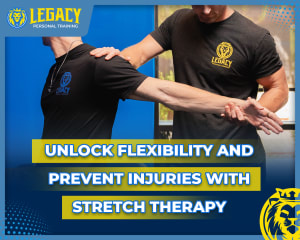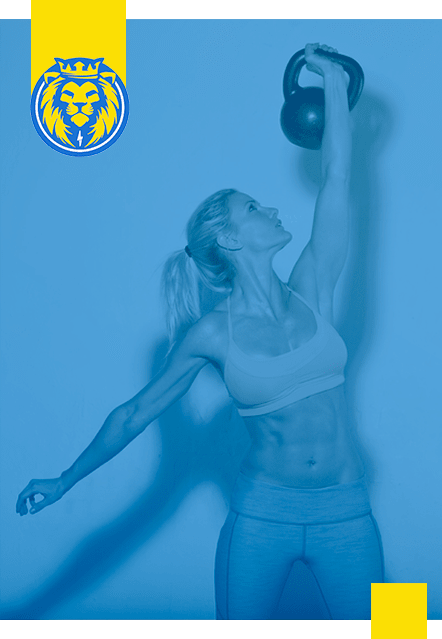
As we age, it’s common to notice more stiffness, tightness, and even fear of injury during exercise or daily movement. These physical limitations aren’t signs of getting old; they’re signs of underutilized flexibility and mobility. The good news? You can fix that. Whether you're lifting weights, walking the dog, or picking up grandkids, mobility and flexibility are essential for moving well, feeling great, and staying injury-free. In fact, consistent stretching can be the missing link that allows you to train more often, get stronger, and avoid setbacks. At Legacy Personal Training, we emphasize stretching and mobility work as a core part of our approach, especially for clients in their 40s, 50s, and 60s who want to maintain strength, reduce pain, and feel more capable in everyday life. Here’s why stretching matters, how often you should do it, and what results to expect when you start giving it the attention it deserves. When people talk about getting hurt, it’s usually not because of a single intense movement. More often, it’s the small, unexpected moments like catching yourself from a stumble, reaching awkwardly, or twisting quickly that trigger strains, pulls, or even long-term injuries. Stretching helps protect you from those moments. When your joints are mobile and your muscles can lengthen comfortably, your body becomes more adaptable. That agility translates to better reaction time and improved recovery in real-world scenarios. Mobility and flexibility also keep your joints aligned and muscles functioning the way they’re meant to. When muscles are tight or imbalanced, your body compensates, often placing extra strain on your knees, hips, back, or shoulders. That’s why consistent stretching is a key part of our injury prevention strategy. Flexibility isn’t just about your muscles. Your nervous system plays a massive role in how your body perceives and responds to stretch. When you stretch too aggressively or too infrequently, your nervous system interprets the movement as a threat. The result? Resistance, tightness, or even pain. But when you gradually introduce new ranges of motion in a calm, consistent way, your nervous system begins to trust that movement is safe. Over time, your body lets go of tension. You feel looser, more capable, and more resilient under stress. That’s why our stretch therapy sessions use a progressive approach. We apply light, controlled pressure to ease the body into new positions, back off, and then reintroduce the range again. That rhythm trains your brain and body to work together — improving movement without triggering stress responses. Stretching once a month or sporadically before workouts won’t deliver long-term change. Just like strength training, mobility requires regular exposure to create lasting adaptation. Ideally, flexibility work should be part of your weekly routine. That might mean attending guided stretch sessions, building mobility into your warm-ups, or following a short daily routine at home. The goal isn’t to stretch for hours, but to build a habit of intentional movement that keeps your body open and fluid. This is especially important if you have a sedentary job, sit for long hours, or already deal with tight hips, shoulders, or hamstrings. The more consistent you are, the more your body will respond — and the easier your workouts will feel. When your mobility improves, so does your performance. You’ll notice better range in squats, smoother reps on presses, and a stronger core connection during every movement. Clients often tell us they feel more in control of their body — not just stronger, but more stable and confident. They move with ease rather than tension, and their results show it. Stretching also enhances recovery. By improving circulation and reducing muscular restrictions, you can train more frequently and with greater intensity — all without burning out or breaking down. Most people think stretching is just about muscles. However, there is a connective tissue called fascia that runs throughout your entire body, which plays a massive role in how you move and feel. Fascia connects muscle to muscle, bone to bone, and muscle to bone. When it becomes tight or restricted, it limits movement and creates discomfort. Our manual stretch sessions help release fascial tension in ways that traditional stretching or foam rolling can’t. By loosening up those in-between spaces, you experience a more open, fluid sensation in your body. That translates to bigger, more confident movements in the gym and fewer limits in everyday life. Mobility work isn’t just about physical function. It can actually help you build a stronger, more adaptive nervous system. When you stretch gently and breathe through the discomfort, you're teaching your body how to stay calm under mild stress. This process is similar to cold plunging or sauna use, where controlled discomfort builds mental resilience. Over time, you become more comfortable in uncomfortable positions. That makes it easier to adapt to stressors in the gym and in life — because your body and brain have already practiced staying calm and capable. Flexibility naturally declines as we get older, especially when stretching and movement are neglected. But this loss isn’t inevitable. It’s simply the result of disuse. You can maintain and even improve your range of motion well into your 70s and 80s but only if you prioritize it. At Legacy, we see this every day. Clients who stretch consistently move better, recover faster, and report fewer aches and pains. Some come to us after years of nagging discomfort, only to discover that tightness and imbalance — not aging — were the real issue. Mobility training isn’t about touching your toes or doing the splits. It’s about being able to get up and down easily, reach overhead without strain, and walk or exercise without pain holding you back. It’s about feeling confident and in control of your body, no matter your age or experience level. That’s why stretching and mobility aren’t optional at Legacy. They’re integrated into everything we do — from warm-ups and cooldowns to dedicated stretch sessions for those who want to take their movement to the next level. Whether you’re recovering from injury, battling tight hips, or simply want to feel stronger and more agile, we’re here to help. Our team of experienced coaches and stretch specialists will guide you through a personalized plan that restores movement, relieves tension, and supports your long-term goals. We serve adults 40 and over who are ready to train smarter, move better, and feel their best for decades to come. Legacy Personal Training proudly serves the Grayhawk and North Scottsdale community. 📅 Book your consultation today and take the first step toward greater flexibility, fewer injuries, and a stronger, more capable body. You don’t have to accept stiffness or pain as a part of aging. Stretching is strength — and it’s never too late to start.Unlock Flexibility and Prevent Injuries with Stretch Therapy
Injury Prevention Starts with Mobility
The Role of the Nervous System in Flexibility
Consistency Is Key: Why Once a Week Isn’t EnoughImproved Movement Means Better Results in the Gym
Fascia: The Missing Link in Movement
Stretching as Stress Resilience Training
Everyone Loses Mobility with Age — Unless You Fight for It
You Deserve to Move Without Pain
Experience Better Mobility with Legacy Personal Training

